Pub names
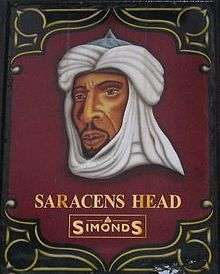
Pub names are used to identify and differentiate pubs. Many pubs are centuries old, from a time when their customers were often illiterate, but could recognise pictorial signs. Pub names have a variety of origins, from objects used as simple identification marks to the coats of arms of kings or local aristocrats and landowners. Other names come from historic events, livery companies, and occupations or craftsmen's guilds.
Unlike Ireland, where the names of pubs tend to be based on the name of the owner, or a former owner, in mainland Britain this has been unusual, probably because pubs wanted names that could be related to an image on their pub sign, a key means of identifying them in an age of restricted literacy. In Australia a high proportion of older pubs have names ending in "hotel", and generally their names reflect hotel naming conventions.
Methodology
Although the word The appears on much pub signage, it is not considered to be an important part of the name, and is therefore ignored in the following examples. The word Ye is likewise ignored as it is only an archaic spelling of The. Y represents an obsolete character (þ, the letter Thorn, which is nowadays used only in Icelandic) for the th sound and its later forms looked rather like a blackletter y. It was never pronounced with a y sound.[1] Similarly, other archaic spellings such as "olde worlde" are not distinguished below.
Animals
Names like Fox and Hounds, Dog and Duck, Dog and Gun, etc., refer to hunting.[2] Animal names coupled with colours, such as White Hart and Red Lion, are often heraldic. A white hart featured as the badge of King Richard II, while a red lion was the badge of John of Gaunt and a blue boar of the Earls of Oxford.[3]
Branding
Some pub chains in the UK adopt the same or similar names for many pubs as a means of brand expression. The principal examples of this are "The Moon Under Water", commonly used by the JD Wetherspoon chain, and inspired by George Orwell's 1946 essay in the Evening Standard, "The Moon Under Water".[4]) and the "Tap and Spile" brand name used by the now defunct Century Inns chain. The "Slug and Lettuce" is another example of a chain of food-based pubs with a prominent brand—founder Hugh Corbett had owned a small number of pubs, which he rechristened with humorous or nonsensical names, with the effect of differentiating them from competitors.
Found objects

Before painted inn signs became commonplace, medieval publicans often identify their establishment by hanging or standing a distinctive object outside the pub. This tradition dates back to Roman times, when the owners of tabernae used to hang some vine leaves outside their property to show where wine was sold.[5]
- Boot
- Copper Kettle
- Crooked Billet (a bent branch from a tree)
Sometimes the object was coloured, such as Blue Post or Blue Door.[6]
Heraldry
The ubiquity of the naming element arms shows how important heraldry has been in the naming of pubs. The simpler symbols of the heraldic badges of royalty or local nobility give rise to many of the most common pub names.
Items appearing in coats of arms
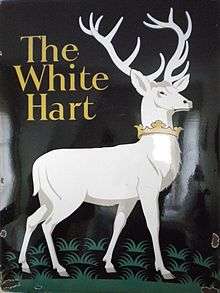
- Antlers: although this is often seen as a derivation of Richard II's white hart emblem, it may also be an echo of a pagan figure, Herne the Hunter.
- Bear and Ragged Staff: a badge of the earls of Warwick. Refers to bear baiting (see Dog and Bear in the Sports section).
- Black Griffin: a pub in Lisvane, Cardiff, named after the coat of arms carried by the lords of the manor.
- Old Black Lion is the name of an ancient pub opposite the railway station in Northampton.
- Blue Boar, the name of many pubs in Westminster, Norwich, Billericay, Maldon, Witney and elsewhere, from the badge of the Earls of Oxford.[3]
- Castle: sometimes originally referred to the Coat of Arms of Castile in Spain, and meant that Spanish wines were available within.[7]
- Checkers or Chequers: often derived from the coat of arms of a local landowner (see Chequy), this name and sign originated in ancient Rome when a chequer board indicated that a bar also provided banking services. The checked board was used as an aid to counting and is the origin of the word exchequer. The last pub to use the older, now American spelling of checker was in Baldock, Hertfordshire, but this closed circa 1990; all pubs now use the modern "q" spelling (but see also Chequers, in Plants and horticulture below).
- Eagle and Child, Oxford, derived from the arms of the Earls of Derby, was a meeting place of the Inklings.
- Elephant and Castle: apocryphally a corruption of the words "Infanta of Castile", more probably taken from the crest of the Cutlers' Company.
- Lamb and Flag: a common religious symbol, with the Agnus Dei holding the red cross flag that represented the Resurrection of Christ earlier than it was the flag of England. This was the device of the Middle Temple, a legal society in London, which was given a charter in 1608 to occupy lands formerly owned by the Knights Templar. It is one of the four Inns of Court, still training barristers today. The Lamb & Flag (Oxford) is one of many pubs with this name.
- Olde Man and Scythe, Bolton, taken from the crest of the Pilkington family.
- Ostrich feathers have been used as a royal badge since the time of Edward III, particularly the Three Feathers badge of the Prince of Wales.
- Red Dragon of Cadwaladr: the symbol of Wales, and a heraldic badge of Henry VII and many other royal figures.
- Red Lion is the name of over 600 pubs. It thus can stand for an archetypal British pub. The lion is one of the most common charges in coats of arms, second only to the cross, and thus the Red Lion as a pub sign probably has multiple origins: in the arms or crest of a local landowner, now perhaps forgotten; as a personal badge of John of Gaunt, founder of the House of Lancaster; or in the royal arms of Scotland, conjoined to the arms of England after the Stuart succession in 1603.[8][3]
- Rising Sun: symbol of the east and of optimism. The Sun In Splendour was also a livery badge of Edward IV
- Silver Lion, Lilley, Hertfordshire: from the arms of the Sowerby family.
- Spread Eagle: from the heraldic depiction of an eagle 'displayed'; probably derived from the arms of Germany, indicating that German wines were available within.[7]
- Swan, a badge of many Lancastrian figures—see Dunstable Swan Jewel
- Talbot or Talbot Arms refers to an actual breed of hunting dog, now extinct, which is also a heraldic hound, and is the badge of the Talbot family, Earls of Shrewsbury.
- Unicorn
- White Bear
- White Hart: the livery badge of King Richard II of England. It became so popular as an inn sign in his reign that it was adopted by many later inns and taverns.[3]
- White Horse: the sign of the House of Hanover, adopted by many eighteenth-century inns to demonstrate loyalty to the new Royal dynasty. A white horse is also the emblem of the County of Kent. The name can also refer to the chalk horses carved into hillsides.
- White Lion: the livery badge of the Duke of Norfolk
Livery companies
.jpg)
Names starting with the word "Three" are often based on the arms of a London Livery company or trade guild :
- Three Arrows: The Worshipful Company of Bowyers
- Three Bucks: The Worshipful Company of Leathersellers
- Three Castles: The Worshipful Company of Masons
- Three Compasses: The Worshipful Company of Carpenters
- Three Crowns: The Worshipful Company of Drapers, although it can also refer to the Magi, or the Diocese of Ely
- Three Cups: The Worshipful Company of Salters
- Three Goats' Heads: The Worshipful Company of Cordwainers
- Three Hammers: The Worshipful Company of Blacksmiths
- Three Horseshoes: The Worshipful Company of Farriers
- Three Tuns: The Brewers and the Worshipful Company of Vintners
- Three Wheatsheafs: The Worshipful Company of Bakers
Landowners
Many coats of arms appear as pub signs, usually honouring a local landowner.
- Percy Arms, Otterburn, Northumberland, commemorates the Battle of Otterburn in 1388, where Sir Henry Percy, son of the Earl of Northumberland, led the English army. There is also a Percy Arms in Tynemouth, North Tyneside, and various other locations in the North East of England.
- Stanley Arms, Huyton, near Liverpool: after Frederick Stanley, 16th Earl of Derby.
- Melbourne Arms, Duston, Northampton: after former local landowner Lord Melbourne
Occupations
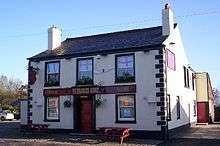
- See also Trades, tools and products below
Some "Arms" signs refer to working occupations. These may show people undertaking such work or the arms of the appropriate London livery company. This class of name may be only just a name but there are stories behind some of them.
- Artillery Arms Bunhill Row, London EC1: situated next door to the headquarters of the Honourable Artillery Company, the British Army's oldest regiment.
- Blacksmith's Arms, with the pun of the actual blacksmiths arms and their strength
- Bricklayer's Arms, e.g., Hitchin, Hertfordshire: The first landlord, William Huckle, who opened this pub in 1846, was a bricklayer by trade.
- Builders Arms: Kensington Court Place, London
- Carpenters Arms - A series of pubs, related to the occupation or more likely to the guild of carpenters.[2]
- Fisherman's Arms, Birgham near Coldstream
- Foundryman's Arms Northampton
- Mason's Arms
- Mechanics Arms (now renamed the Old Neighbourhood), near Stroud, Gloucestershire. In this context a mechanic was a bonesetter.
- Plumbers Arms (Lower Belgrave Street, London SW1).
- Waterman's Arms
Historic events
- Alma: commemorating the Battle of the Alma which took place in 1854, during the Crimean War.
- Bhurtpore Inn, Aston, near Nantwich, Cheshire: commemorating the Siege of Bharatpur in Rajasthan, 1826.[9] The Inn is on land formerly part of the estates of Lord Combermere, commander of British forces during the siege.
- Dolphin: often anglicised from the French Dauphin, commemorating battles in which England defeated France. These include "The Dolphin" in Wellington, Somerset which was named in honour of Wellington's victory at the Battle of Waterloo.[10]
- Festival Inn: name of a pub in Poplar, London, built at the time of the Festival of Britain in 1951.
- Hand and Shears: this famous City of London pub got its name owing to Bartholomew Fair. Tailors would gather in the pub the night before the fair and wave their shears announcing that the fair should begin.[11]
- Magna Charta in Lowdham, Nottinghamshire, has its name spelled differently from the historic document after which it is named.
- Man on the Moon, Northfield, Birmingham: originally called The Man in the Moon and renamed on the day of the first moon landing in 1969.
- Rose and Crown: Edward III used a golden rose as a personal badge, and two of his sons adapted it by changing the colour: John of Gaunt, 1st Duke of Lancaster, used a red rose, and Edmund of Langley, 1st Duke of York, used a white rose. The dynastic conflicts between their descendants are collectively called the Wars of the Roses. In 1485 Henry Tudor, a descendant of Lancaster, defeated Richard III of the York dynasty and married Richard's niece Elizabeth of York. Since then the combined red-and-white Tudor rose, often crowned, has been a symbol of the monarchy of England.
- Royal Oak: After the Battle of Worcester (1651) in the English Civil War, the defeated Prince Charles escaped the scene with the Roundheads on his tail. He managed to reach Bishops Wood in Staffordshire, where he found an oak tree (now known as the Boscobel Oak near Boscobel House). He climbed the tree and hid in it for a day while his obviously short-sighted pursuers strolled around under the tree looking for him. The hunters gave up, Prince Charles came down and escaped to France (the Escape of Charles II). He became Charles II on the Restoration of the Monarchy. To celebrate this good fortune, 29 May (Charles' birthday) was declared Royal Oak Day and the pub name remembers this. The Royal Naval ship HMS Royal Oak gets its name from the same source. Early ships were built of the heartwood of oak.
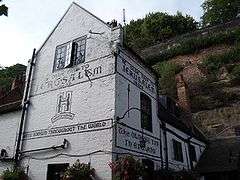
- Saracen's Head and Turk's Head: Saracens and Turks were among the enemies faced by Crusaders. This is also a reference to the Barbary pirates that raided the coasts from the Crusades until the early 19th century.
- Trafalgar: commemorating the Battle of Trafalgar. There are many pubs called the Nelson, and an Emma Hamilton pub in Wimbledon Chase where Nelson lived with her. A famous pub is the Trafalgar Tavern, part of the Greenwich Maritime World Heritage site at Greenwich.
- Olde Trip to Jerusalem, Nottingham, one of the claimants to the title of oldest pub in Britain, said to have been a stopping-off place for the Crusaders on the way to the Holy Land. "Trip" here has the old meaning of a stop, not the modern journey. The pub was once called the Pilgrim, which is probably the real story behind the name. The pub has the date 1189 painted on its masonry, which is the year King Richard I ascended to the throne. Like many elderly pubs, the Trip carries "Ye" before its name, with an E on the end of "old" another "olde worlde" affectation.
Literature
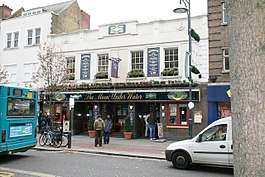
- Cat and Custard Pot in Shipton Moyne is said to originate from the book Handley Cross or Mr Jorrocks's Hunt by R. S. Surtees.[12]
- Jabez Clegg in Manchester, now closed, was named after the title character in Isabella Banks' novel The Manchester Man.[13]
- Hobbit in Southampton, named after J. R. R. Tolkien's creation and threatened with legal action by US movie lawyers, because of this.[14]
- Lass O' Gowrie in Manchester, named after the poem by Carolina Nairne.[15]
- Moon and Sixpence pubs in Portland, Oregon; Whitby, North Yorkshire; Harrow, Middlesex; and Soho, London are named after Somerset Maugham's novel of the same name.[16]
- Moon Under Water, inspired by George Orwell's essay describing his perfect pub[17]
- Peveril of the Peak, in Manchester, commemorates a stagecoach that once connected Manchester and London, but the pub itself claims it is named for the novel by Sir Walter Scott.[18]
- Sherlock Holmes in Charing Cross, London contains a reproduction of the great detective's study.[19]
- Herbert Wells in Woking, a town that was fictionally destroyed by Martian invaders in H. G. Wells's The War of the Worlds. A 7.6 metre tall statue of a Martian stands in Crown Passage in the town, and a Martian is depicted in a drawing in the pub.[20]
- Edgar Wallace, The Strand, London, named for the 1930s mystery writer.[21]
- John Masefield in New Ferry, named for the former Poet Laureate who served for some years on a naval training ship, HMS Conway, off New Ferry pier.[22]
Myths and legends
Images from myths and legends are evocative and memorable.
- Black Horse (Black Bess): usually named after the legendary overnight ride from London to York in 1737 by Dick Turpin. This fictional account was popularised in a novel, Rookwood (1834), resulting in a surge of Dick Turpin nostalgia and associated pub names.
- Fiddler's Green, a legendary place in the afterlife where existence consists of all leisure and no work.
- George and Dragon: St George is the patron saint of England and his conflict with a dragon is essential to his story. This sign is a symbol of English nationalism.
- Green Man: a spirit of the wild woods.[23] The original images are in churches as a face peering through or made of leaves and petals; this character is the Will of the Wisp, the Jack of the Green. Some pub signs will show the green man as he appears in English traditional sword dances (in green hats). The Green Man is not the same character as Robin Hood, although the two may be linked. Some pubs which were the Green Man have become the Robin Hood; there are no pubs in Robin's own county of Nottinghamshire named the Green Man but there are Robin Hoods. The 1973 film The Wicker Man features a Green Man pub.
- Moonrakers: In the 17th century, some Wiltshire yokels hid their smuggled liquor in the Crammer (a pond in Devizes) and used rakes to recover their stash. They were caught in the act by customs officials and they claimed they were trying to rake in a cheese, which was in fact the reflection of the full moon. The customs officials left thinking that the locals were a bit simple, whilst the locals recovered the smuggled goods without any more interference. The name Moonrakers has been used as a nickname for Wiltshire folk ever since and is the name of pubs in Devizes and Swindon.
- Robin Hood, sometimes partnered by his second in charge to form the name Robin Hood and Little John. Other Robin Hood names can be found throughout Arnold, Nottinghamshire. These were given to pubs built in the new estates of the 1960s by the Home Brewery of Daybrook, Nottinghamshire: Arrow, Friar Tuck, Longbow, Maid Marian and Major Oak.
- Silent Woman, Quiet Lady or Headless Woman: The origin is uncertain, with various local stories, such as a landlady whose tongue was cut out by smugglers so she couldn't talk to the authorities,[24] or a saint beheaded for her Christianity.[25] The pub signs sometimes have an image of a decapitated woman or the couplet: "Here is a woman who has lost her head / She's quiet now—you see she's dead".[25]
- Captain's Wife, near the medieval trading port of Swanbridge on the south Wales coast near Penarth. The pub was converted during the 1970s from a row of fishermen's cottages. There is a local legend of a ghostly wife keeping endless vigil after her husband's boat was lost in a storm.
Paired names
Common enough today, the pairing of words in the name of an inn or tavern was rare before the mid-17th century, but by 1708 had become frequent enough for a pamphlet to complain of 'the variety and contradictory language of the signs', citing absurdities such as 'Bull and Mouth', 'Whale and Cow', and 'Shovel and Boot'. Two years later an essay in the Spectator echoed this complaint, deriding among others such contemporary paired names as 'Bell and Neat's Tongue', though accepting 'Cat and Fiddle'. A possible explanation for doubling of names is the combining of businesses, for example when a landlord of one pub moved to another premises. Fashion, as in the rise of intentionally amusing paired names like 'Slug and Lettuce' and 'Frog and Firkin' (see Puns, Jokes and Corruptions below) in the late 20th century, is responsible for many more recent pub names.[26]
Personal names or titles
Some pubs are known by the names of former landlords and landladies, for instance Nellie's (originally the White Horse) in Beverley, and Ma Pardoe's (officially the Olde Swan) in Netherton, West Midlands. The Baron of Beef, Welwyn, Hertfordshire is named after a nineteenth-century landlord, George Baron, listed in Kelly's Directory for 1890 as "Butcher and Beer Retailer". Others are named after various people.
- General Burgoyne
- Duke of Cambridge
- General Elliot
- Marquis of Granby: a general in the 18th century. He showed a great concern for the welfare of his men upon their retirement and provided funds for many ex-soldiers to establish taverns, which were subsequently named after him.[27] (See right).
- Nell Gwyn: mistress of Charles II.
- Lord Nelson: Quite a common name (in various forms) throughout England but especially in Norfolk, where the admiral was born. The Hero of Norfolk at Swaffham, Norfolk, portrays Nelson.
- Guy Earl of Warwick, in Welling, Dartford,[28] dates from at least 1896.[29] and is thought to be the "Halfway House" which appears in Charles Dickens' 1861 Great Expectations.[30]
- Duke of Wellington
Places
- Tavistock Inn, as for example at Poundsgate, Dartmoor.[31]
- The Bailey Head a new name for the former Castle Tavern or Eagles sited on the Bailey Head, the name of the market square in Oswestry
- Beachy Head
- London Inn
- Mutley Tavern in Mutley Plain, Plymouth
- Plymouth Inn
- Twelve Pins or Na Beanna Beola (Finsbury Park, London): the Twelve Pins mountain range in the west of Ireland.[32]
- Cheviot Inn, Bellingham, Northumberland: a range of hills, the Cheviot Hills, of which the highest is locally called The Cheviot.
- Kentish Horse
An "arms" name, too, can derive from a pub's town.
- Bedford Arms, Bedford Road, Hitchin, Hertfordshire, shows the arms of the town of Bedford. The more usual derivation is for the Duke of Bedford whose seat is at the nearby Woburn Abbey.
Plants and horticulture
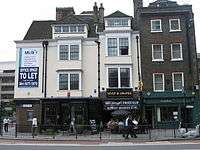
The most common tree-based pub name is the Royal Oak, which refers to a Historical event.
- Bush, Holly Bush, Mulberry Bush etc. refer to plants, but note that Bull and Bush refers to a battle (see Historical event above).
- Chequers from the Wild Service Tree or "Chequer(s) Tree", the fruit of which was used to flavour beer before the introduction of hops.
- Crabtree would refer to a crab apple tree growing nearby or in the grounds, as pubs are often free standing.
- Flower Pot, Maidstone, Kent, Aston, Oxfordshire, Henley-on-Thames. Flowerpots, Cheriton, Hampshire.
- Hand and Flower, Hammersmith, London, also Ham, Surrey. Hand and Flowers, Marlow.
- Major Oak, Nottingham. Named after an ancient tree, and locally associated with Robin Hood
- Pineapple, e.g. in The Pineapple, Kentish Town, also Berkshire and Oldham.
- Tulip, Chelmsford.
- Vine or Grapes possibly harks back to the Roman custom of displaying a vine outside a tavern or wine-shop, as in The Hoop and Grapes in Aldgate High Street, London (reputed to be the city's oldest pub).
Politically incorrect
- All labour in vain or Labour in vain. At various locations. Probably of Biblical origins, in past times the name was often illustrated by a person trying to scrub the blackness off a black child. Such signs, now deemed offensive, have been mostly replaced with more innocuous depictions of wasted effort.[33]
- There are numerous old pubs and inns in England with the name of the Black Boy, many now claimed to refer either to child chimneysweeps or coal miners, or to a (genuine) historic description of King Charles II. The Black Boy Inn, Caernarfon, North Wales, has received at least a dozen complaints from visitors over the name, which dates back at least 250 years. However, the police say they have not received any formal complaints.[34]
- The Black Bitch, a pub in Linlithgow, West Lothian, is named after the local legend of a black greyhound who is said to have repeatedly swum to an island in the town's loch to bring food to its imprisoned master, only to suffer the same fate when its efforts were discovered. The pub's name has caused more than a few surprised tourists to question the name or decry it as racist.[35]
The pub itself (including nicknames)
The pub building
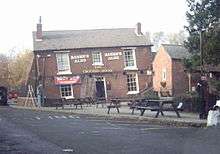
- Candlestick, West End, Essendon, Hertfordshire: Once the Chequers, lit by a single candle and plunged into darkness when the landlord took the candle to the cellar to fetch beer.
- Crooked Chimney, Lemsford, Hertfordshire: The pub's chimney is distinctively crooked.
- Crooked House, nickname of the Glynne Arms, Himley, Staffordshire. Because of mining subsidence, one side of the pub has a pronounced list.
- Cupola House, Bury St Edmunds, Suffolk, has a cupola on its roof.
- Hole in the Wall. The official name or nickname of a number of very small pubs. One such at Waterloo, London, is spacious but built into a railway viaduct.
- Jackson Stops, Stretton, Rutland: The pub was once closed for a period when the only sign on the outside was that of London estate agent Jackson Stops. The name stuck.
- Kilt and Clover, Port Dalhousie, Ontario, named after the owners. The husband is of Scottish descent, and the wife is of Irish heritage. The split theme runs throughout the pub.
- New Inn. Pubs can bear this name for centuries.
- Nutshell, Bury St Edmunds: one of the foremost claimants to be the smallest pub in the UK and maybe the world.
- Push Inn, Beverley: At one time the pub had no external sign except for that on the entrance door which read, simply, PUSH.
- Red House, Newport Pagnell, and on the old A43 between Northampton and Kettering: red or reddish painted buildings.
- Swiss Cottage was built in Swiss chalet style. It gave its name to an underground station and an area of London.
- Swiss Gardens, Shoreham-by-Sea, originally the pub of a Swiss-themed Victorian picnic garden and amusement park.
- Vaults, a number of pubs, not all having vaults as an architectural feature; the word also had the general meaning of 'storeroom'.[36] By extension 'the vaults' was formerly used to designate a particular type of bar. At a time (mid 19th-mid 20th century) when the several areas in a pub served different clientele, 'the vaults' would cater largely for working-class drinkers and would most usually be men-only.
- White Elephant, Northampton, Northamptonshire. Originally built as a hotel to accommodate visitors to the adjacent Northampton Racecourse, the building became a "white elephant" (useless object) when horse racing was stopped at Northampton Racecourse in 1904.
Services provided by the pub
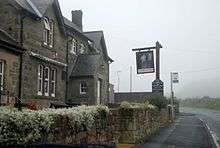
Beer and wine
.jpg)
Many traditional pub names refer to the drinks available inside, most often beer.
- Barley Mow: a stack (or sheaf) of barley, the principal grain from which beer is made.
- Barrels: A cask or keg containing 36 Imperial gallons of liquid, especially beer. Other sizes include: pin, 36 pints; firkin, 9 gallons; kilderkin, 18 gallons; half-hogshead, 27 gallons; hogshead, 54 gallons; butt, probably 104 gallons.
- Brewery Tap: A pub originally found on site or adjacent to a brewery and often showcasing its products to visitors; although, now that so many breweries have closed, the house may be nowhere near an open brewery.
- Cock and Bottle, or simply Cock: The stopcock used to serve beer from a barrel, and a beer bottle.[37]
- Hop Inn: Hop flowers are the ingredient in beer which gives it its bitter taste, though this name is often intended as a pun.
- Hop Pole: The poles which support wires or ropes up which hops grow in the field.
- (Sir) John Barleycorn: A character of English traditional folk music and folklore, similar to a Green Man. He is annually cut down at the ankles, thrashed, but always reappears—an allegory of growth and harvest based on barley.
- Leather(n) Bottle: A container in which a small amount of beer or wine was transported, now replaced by a bottle or can.
- Malt Shovel: A shovel used in a malting to turn over the barley grain.
- Mash Tun: a brewery vessel used to mix grains with water.
- Three Tuns: Based on the arms of two City of London guilds, the Worshipful Company of Vintners and the Worshipful Company of Brewers.
Food

Other pub names refer to items of food to tempt the hungry traveller. For example, The Baron of Beef in Cambridge refers to a double sirloin joined at the backbone.[38]
Puns, jokes and corruptions
Although puns became increasingly popular through the twentieth century, they should be considered with care. Supposed corruptions of foreign phrases usually have much simpler explanations. Many old names for pubs that appear nonsensical are often alleged to have come from corruptions of slogans or phrases, such as "The Bag o'Nails" (Bacchanals), "The Cat and the Fiddle" (Caton Fidele) and "The Bull and Bush", which purportedly celebrates the victory of Henry VIII at "Boulogne Bouche" or Boulogne-sur-Mer Harbour.[39][40] Often, these corruptions evoke a visual image which comes to signify the pub; these images had particular importance for identifying a pub on signs and other media before literacy became widespread. Sometimes the basis of a nickname is not the name, but its pictorial representation on the sign that becomes corrupt, through weathering, or unskillful paintwork by an amateur artist. Apparently, many pubs called the Cat or Cat and Custard Pot were originally Tigers or Red Lions with signs that "looked more like a cat" in the opinion of locals.
- Axe and Gate: Possibly from "ax (or ask) and get".[41]
- Bag o'Nails: Thought by the romantic to be a corrupted version of "Bacchanals" but really is just a sign once used by ironmongers. The pub of this name in Bristol, England was named in the 1990s for the former reason, though the latter is more prevalent.
- Barge Inn. A play on words 'barge in'. The Barge Inn in Bradford-on-Avon, Wiltshire is however actually on a canal, where barges tie up.
- Beartown Tap, Congleton, Cheshire. 'Beartown' is the nickname for Congleton, as local legend claims its townsfolk once 'sold the bible to buy the bear', that is, spent money set aside to buy a parish Bible on providing bear-baiting at their fair.[42]
- Bent Brief, once close to the Honest Lawyer on Lodge Road, Southampton.
- Bird and Baby, the familiar name used by the Inklings for the Eagle and Child pub in Oxford (see above under Heraldry).
- Buck and Ear in the Steveston area of Richmond, British Columbia. The name alludes not only to the maritime heritage of the area but also to a previous establishment at the same location that was called "The Buccaneer".[43]
- Bull and Mouth: Believed to celebrate the victory of Henry VIII at "Boulogne Mouth" or Harbour. Also applies to Bull and Bush (Boulogne Bouche).
- Case is Altered: The title of an early comedy by Ben Jonson, first published in 1609, based on a remark by lawyer Edmund Plowden which entered into common currency. Also said to be a corruption of the Latin phrase Casa Alta ('high house') or Casa Altera ('second house'). There are several examples in England, such as at Hatton, Warwickshire[44]
- Cat and Fiddle: a corruption of Caton le Fidèle (a governor of Calais loyal to King Edward III).[45] Alternatively from Katherine la Fidèle, Henry VIII's first wife.
- Cock and Bull: a play on "cock and bull story". This term is said to derive from the Cock and the Bull, two pubs in Stony Stratford, Buckinghamshire, which are close neighbours and rival coaching inns.
- Dew Drop Inn: A pun on "do drop in".
- Dirty Duck: The Black Swan, as in Stratford-on-Avon; also The Mucky Duck in Portsmouth and the Students Union pub at the University of Warwick
- Dirty Habit: Sited on the route of the Pilgrims' Way, the name is a play on the contemptuous phrase and a reference to the clothing of monks who passed by on a pilgrimage to Canterbury Cathedral.
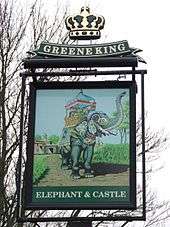
- Elephant and Castle: By folk etymology, a corruption of "la Infanta de Castile". It is popularly believed amongst residents of Elephant and Castle that a 17th-century publican near Newington named his tavern after the Spanish princess who was affianced to King Charles I of England. The prohibition of this marriage by Church authorities in 1623 was a cause of war with Spain so it seems unlikely to have been a popular name. A more probable and prosaic explanation is that the name derives from the arms of the Worshipful Company of Cutlers, a London trade guild; an elephant carrying a castle-shaped howdah can also be seen on the arms of the City of Coventry.
- Fawcett Inn ("force it in"), Portsmouth.
- Gate Hangs Well, common in the Midlands: "This Gate Hangs Well, and hinders none. Refresh and pay and travel on." Also frequently found as 'Hanging Gate'.
- Goat and Compass[es]: Possibly based on the arms of the Worshipful Company of Cordwainers, whose coat of arms contains three goats, together with the Worshipful Company of Carpenters, whoses coat of arms contains three compasses.[46] (either that, or from "God encompass us")[41]
- Honest Lawyer Folkestone, The Honest Politician, Portsmouth.
- Hop Inn: similar to the Dew Drop Inn. A double pun in that hops are a major ingredient in beer making.
- Jolly Taxpayer in Portsmouth.
- Letters Inn ("let us in")
- Library: So students and others can say they're in 'the library',
- Nag's Head. Pub signs can play on the double meaning of Nag — a horse or a scolding woman.
- Nowhere, Plymouth; Nowhere Inn Particular, Croydon: Wife calls husband on his mobile and asks where he is. He answers truthfully "Nowhere".
- Office: as above.
- Ostrich, Ipswich: originally Oyster Reach (the old name has since been restored on the advice of historians).
- Paraffin Oil Shop (now closed, at the crossing of A5080 and B5179 in eastern Liverpool, Google Earth view here: So people could say that they are going to buy paraffin.[47]
- Pig and Whistle: a corruption of the Anglo-Saxon saying piggin wassail meaning "good health".
- Swan With Two Necks: In the United Kingdom, swans have traditionally been the property of the reigning monarch. However, in the 16th century, Queen Elizabeth I granted the right to ownership of some swans to the Worshipful Company of Vintners. To tell which swan belonged to whom, it was decided that Vintners' swans' beaks should be marked with two notches, or nicks. The word 'nick' was mistaken for 'neck', and so the Vintners spotted that a Swan With Two Necks could afford them a rather clever pun, and a striking pub sign.
- Three Chimneys, Biddenden: During the Seven Years' War (1756-1763) it is said that up to 3,000 French prisoners were kept at nearby Sissinghurst Castle. The French seamen were placed on parole in the surrounding area and were allowed out as far as the pub building. At the time locals referred to this as the 'Three Wents' (or three ways) but the prisoners called it Les Trois Chemins. The unique name of the Three Chimneys therefore derives from the French term for the junction of three roads.
Religious
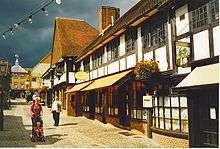
The amount of religious symbolism in pub names decreased after Henry VIII's break from the church of Rome. For instance, many pubs now called the King's Head were originally called the Pope's Head.
- Anchor, Hope & Anchor, Anchor & Hope: From the Letter to the Hebrews (6:19): "We have this as a sure and steadfast anchor of the soul, a hope."
- Cross Keys: The sign of St Peter, the gatekeeper of Heaven. Often found near a church dedicated to St Peter. When people walked to the Sunday service they often stayed afterwards, at a house near the church, to drink beer and to watch or participate in sporting events. These venues became known as pubs and would use the sign of the saint to which the church was dedicated - the Cross Keys for St Peter, an Eagle for St John, a Lion for St Mark. The sporting events might include the racing or fighting of dogs, bulls, cocks or pheasants, or the hunting of foxes, with or without hounds - thus giving rise to further pub signs.
- Lamb & Flag: From the Gospel of John (1:29): "Behold the Lamb of God, which taketh away the sins of the world." The Lamb is seen carrying a flag (usually of St. George) and is the symbol of the Knights Templar, the Worshipful Company of Merchant Taylors, and St John's College, Oxford. A pub of this name appeared in the popular BBC sitcom Bottom.
- Five Ways: Possibly referring to the "Five Ways" of Thomas Aquinas, five reasons for the existence of God.
- Lion & Lamb: The lion is a symbol of the Resurrection, the lamb a symbol of the Redeemer.
- Mitre: A bishop's headgear, a simple sign easily recognisable by the illiterate. In Glastonbury and in Oxford a Mitre is adjacent to a church.
- Salutation: The greeting of the Archangel Gabriel to Mary when informing her she was to carry Jesus Christ.
- Shepherd & Flock may refer to Christ (the Shepherd) and the people (his flock) but may also just mean the agricultural character and his charges.
- Three Crowns: The Magi, but also see Heraldry above.
- Three Kings: The Magi.
- Parish: In Huddersfield, Originally called "The Parish Pump", Referring to its close proximity to Huddersfield Parish Church.
Royalty
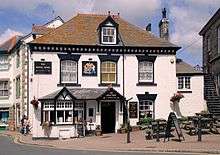
Royal names have always been popular (except under the Commonwealth). It demonstrated the landlord's loyalty to authority (whether he was loyal or not), especially after the restoration of the monarchy.
- Crown
- King's Arms
- King's Head
- King and Queen: Celebrates the dual monarchy of William III and Mary II.
- Queen's Arms
- Queen's Head
- British Queen
- Alexandra: wife of Edward VII.
- Prince Arthur: (e.g. in Brighton) third son of Queen Victoria. His son, also Arthur, is usually referred to as the Duke of Connaught, another pub name.
- Prince Leopold, Southsea, Portsmouth, Hampshire: Queen Victoria's fourth son.
- Queen Victoria reigned at the time of greatest expansion of housing stock and associated pubs, and at the height of the British Empire. She inspired great loyalty and affection, and publicans aimed to reflect this.
- Prince of Wales: the title of the heir to the monarchy was also popular in Victorian times, when Albert Edward was the longest-serving holder of the title.
- Princess of Wales: following the death of Diana, Princess of Wales, a number of pubs were renamed Princess of Wales, including the Prince of Wales on Morden Road in South Wimbledon. The sign replaced with an image of a white rose; Diana was called "England's Rose" in a popular song at the time by Elton John.
- Prince Regent: the title of the future George IV, in the Regency period.
- Sovereign
Ships
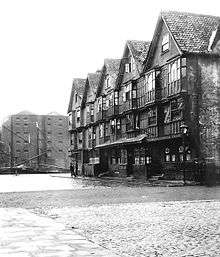
- Albion: at Penarth, near Cardiff, South Wales, and at West Kensington, London
- Ark Royal : the name of five ships of the Royal Navy from 1587, from the time of the Spanish Armada, through the Dardanelles Campaign and the hunt for the Bismarck with the current ship in service since 1981. There is a pub of the name in Wells-next-the-Sea, Norfolk.
- Cutty Sark, a clipper in dry dock and a pub nearby in Greenwich.
- Endeavour, on Whitby's east side, Captain Cook's ship.
- Golden Hind, Portsmouth: Sir Francis Drake's galleon.
- Invincible, Portsmouth: named after the aircraft carrier and battlecruiser associated with the First and Second battles of the Falklands.
- London Trader, Hastings
- Llandoger Trow, Bristol: a 17th-century pub with literary connections.
- Mary Rose, Southsea: named after Henry VIII's battleship of that name.
- Mayflower, famous for sailing the Pilgrim Fathers to Plymouth Colony in 1620. A pub in Rotherhithe.
- Pilot Boat, Bembridge, Isle of Wight and Lyme Regis, Dorset
- Prospect of Whitby, on the north bank of the Thames at Wapping, London.
- Resolute, Poplar High Street, London.
- Royal George, Salisbury, Shoreham-by-Sea, Soho, Workington and may others.
- Sheffield, Barrow-in-Furness (now closed): After HMS Sheffield, built in the local shipyard and sunk in the Falklands War.
- Ship Leopard, near Portsmouth Hard: named after several Royal Navy ships, the most recent having been an anti-aircraft frigate.
- Sloop, Wootton Bridge, Isle of Wight
- Vanguard, Keal Cotes, Lincolnshire (now renamed)
- Victory, Station Road, Chertsey, Surrey, Marble Arch, St. Mawes and elsewhere
- Waverley, Carisbrooke, Isle of Wight: named after the paddle steamer.
Sports

Games
- Bat and Ball: a reference to cricket used by a number of pubs, one of which gave its name to a railway station.
- Boathouse, Cambridge—not far from the real boathouses.
- Bowling Green—Bowls has been for many years a popular sport in the Manchester area: many of the greens are attached to pubs, e.g. the Lloyd's Hotel and the Bowling Green Hotel in Chorlton-cum-Hardy.[48] The Bowling Green Hotel in Grafton Street, Chorlton on Medlock, no longer has a green.[49]
- Cricketers: can be sited near or opposite land on which cricket is (or was) played.
- Cricket Players: a version of the Cricketers found in Nottingham and probably elsewhere.
- Hand and Racquet, Wimbledon, near the All England Lawn Tennis and Croquet Club. A fictional version is referenced several times in Tony Hancock scripts.
- Larwood and Voce, West Bridgford, Nottinghamshire: Harold Larwood and Bill Voce were two internationally renowned fast-bowlers who played for Nottinghamshire and England between the world wars. This pub is at the side of the Trent Bridge cricket ground, the home of Nottingham County Cricket Club.
- Test Match, West Bridgford, Nottinghamshire: an international game of cricket. This beautiful art deco Grade II listed pub is to be found near Trent Bridge at the other end of Central Avenue, a ground on which test matches are played.
- Trent Bridge Inn, West Bridgford, Nottinghamshire, the most famous of cricketing pubs sited on the edge of the Trent Bridge Cricket Ground, is not named after the ground but for the bridge itself. This was a strategic crossing place of the River Trent protected by Nottingham Castle. Ben Clark, the owner of the Inn in 1832, was a cricket enthusiast and decided he would like a cricket pitch in his back garden. It was that small pitch which evolved into one of the world's premier test match venues.
- Wrestlers: Great North Road, Hatfield, Hertfordshire.
- Old Ball: Horsforth, Leeds. next to the Horsforth Cricket club pitch.
Football club nicknames include:
- Hammers, London E6: West Ham United although elsewhere in the country it could refer to blacksmiths (see Heraldry above).
- Magpies, Meadow Lane, Nottingham: Notts County who play close by at the other end of Meadow Lane.
- The Peacock Inn: Elland Road, Leeds. Opposite the Leeds United football ground whose original nickname was taken from the pub.
Hunting and blood sports
- Bird in Hand: the bird sitting on the left gauntlet in falconry.[2]
- Blue Posts: boundary-markers of Soho Fields, the (former) royal hunting grounds to the north-east of Whitehall Palace.
- Dog and Bear: Bear-baiting, where a bear was tethered to a stake and dogs set upon it to see who would kill who first. Bear Inn may refer to the sport or to the coat of arms of a prominent local family.
- Dog and Duck where duck-baiting events were held.[50][2]
- Dog and Gun: Referencing gun dogs. Similarly, Dog and Partridge.
- Fighting Cocks (or just 'Cock'): Cockfighting; but the fighting cock also could be a heraldic charge. Ye Olde Fighting Cocks in Saint Albans rivals Ye Olde Trip to Jerusalem in Nottingham for the title of oldest pub; its name advertised actual cockfighting entertainment in the pub.[2]
- Fox and Hounds (or 'Dog and Fox'): Fox hunting[2]
- Greyhound: for Henry VIII's favourite hunting dog[2] among others
- Hare and Hounds: hunting by beagling or hare coursing,[2] or greyhound racing
- Hark to Bellman: Clitheroe[51] later (1826)[52] the Bellman Inn, named after a hound of the huntsman John Peel, as were the Hark to Bounty in Slaidburn, and the Hark to Towler in Bury; in fox hunting, "hark to" meant to listen.
- Tally Ho: A hunting cry which was also used as a name for a stagecoach. The Tally Ho at Trumpington, Cambridgeshire shows a Spitfire as the call came to be used by some local wartime RAF pilots.
- Bay Horse: West Woodburn, Northumberland. Refers to the use of horses in fox hunting, bay being a colour of horses.
- See Ho Shorne, Kent: a hare coursing term.
- Fox Goes Free (Charlton, West Sussex). Particularly appropriate after the ban on fox hunting in the United Kingdom in the early 2000s.
Topography
- Abbey Inn: located near an abbey, or former abbey
- Bishop's Finger: after a type of signpost found on the Pilgrims' Way in Kent, said to resemble a bishop's finger (also used as the name of a beer by Shepherd Neame Brewery).
- Bridge Inn (often preceded by the name of a bridge) - located near a river or canal bridge: historically these were good places to establish a pub due to passing traffic on both the road and the water.
- Castle: usually a prominent local landmark, but sometimes a heraldic device: see under "Heraldry", above.
- Fountain Inn: Might refer to an actual fountain or natural spring.
- First In, Last Out: A pub on the edge of a town. It's the first pub on the way in and last on the way out. Does not refer to the habits of any of the pub's clientele as some signs suggest.
- Half Way House: This one is situated half-way between two places; but with the pub of this name at Camden Town it's anyone's guess which two places it's half-way between. A similar name is West End House (located at the West side of a town).
- First and Last, nickname of The Redesdale Arms, the nearest pub to the border between England and Scotland, on the A68 between Rochester and Otterburn in Northumberland.
- (number) Mile Inn : Usually the distance to the centre of the nearest prominent town, as in the Four Mile Inn at Bucksburn, Aberdeen, and the Five Mile House, near Cirencester.
- Strugglers, near a gallows, refers to how people being hanged would struggle for air. Ironically the famous executioner Albert Pierrepoint was landlord of the Help the Poor Struggler at Hollinwood, near Oldham, for several years after World War II, and had to hang one of his own regulars, James Corbitt.
- Hangmans Inn, on site of gallows Guernsey
- Tunnel Top: near Runcorn, Cheshire, named for its position over a canal tunnel.
- Windmill: a prominent feature of the local landscape at one point. Pubs with this name may no longer be situated near a standing mill, but there's a good chance they're close to a known site and will almost certainly be on a hill or other such breezy setting. Clues to the presence of a mill may also be found in the naming of local roads and features.
- World's End. A pub on the outskirts of a town, especially if on or beyond the protective city wall. Examples are found in Camden and Edinburgh.
- Three Hills. A pub in the village of Bartlow, Cambridgeshire, named after three barrows close to the border with Essex.
Trades, tools and products
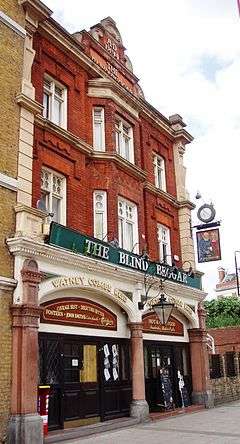
- Axe 'n Cleaver in Much Birch, or Altrincham, also Boston, Lincolnshire and North Somercotes
- Bettle and Chisel in Delabole, Cornwall, from two tools of the slate quarrymen
- Blind Beggar, a pub in Whitechapel named for the story of Henry de Montfort
- Butcher: the Butchers Arms can be found in Aberdeen, Sheepscombe, Stroud, Woolhope and Yeovil
- Compasses, Abbots Langley, Hertfordshire, dates from the 17th Century.
- Chemic Tavern, Leeds, West Yorkshire. Named for the workers at the nearby Woodhouse Chemical Works,(C. 1840-1900) it was a beer house on the 1861 census. The licensee was James Lapish.[53]
- Foresters, Brockenhurst in the New Forest
- Golden Fleece, for the wool trade[2]
- Gun Barrels: at Edgbaston in Birmingham, a city known for its metal-working and gunmaking trades.
- Harrow: A harrow breaks up the soil after it has been turned over by the plough to a finer tilth ready for sowing.
- Harewood End: Hare, Woodland, in Winfrith, Dorset
- New Holly in Forton, Lancashire, named after the busy trade in the supply and cultivation of wreaths and decorations.
- Jolly Nailor in Atherton, Greater Manchester, named after nail manufacture, present in the area since the 14th century.[54]
- Olde Murenger House Newport, Monmouthshire, takes its name from the person in charge of the walls of a town or its repairs, known as murage.
- Oyster Reach at Wherstead, Ipswich
- Pillar of Salt, the name of pubs in Northwich, Cheshire and Droitwich, Worcestershire. Although ostensibly the name refers to Lot's wife as described in the bible, both towns were formerly centres of the salt trade in England.
- Plough: an easy object to find to put outside a pub in the countryside. Some sign artists depict the plough as the constellation; this consists of seven stars and so leads to the name the Seven Stars found in Redcliffe, Bristol, Shincliffe, County Durham, Chancery Lane, Robertsbridge and High Holborn also Winfrith Dorset
- Plough and Harrow, Drakes Broughton, Worcs: A combination of the two farming implements.
- Propeller, Croydon (now closed) and Bembridge.
- Roadmaker, Gorsley and elsewhere.
- Ship Inn from Irvine to Oundle. However, the Ship Inn in Styal, Cheshire, states that its derivation is from 'shippon', a cattle shed or manure shed.[55]
- Sailor, Addingham near Ilkley; Jolly Sailor at St Athan and at Sandown, Isle of Wight.
- Tappers Harker (Long Eaton, Nottingham): a railway worker who listened to the tone of a hammer being hit onto a railway wagon wheel, to check its soundness. Similar to the Wheeltappers and Shunters fictional pub of the 1970s show.
- Town and Gown Cambridge, Cambridgeshire, is named for the non-academic and academic communities of the city respectively.
- Woodman
- Woolpack Banstead, Surrey. Not an uncommon name in sheep country such as the Banstead Downs.
Transport
Air
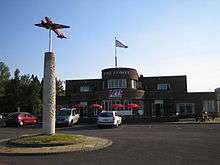
- Airman, Feltham, Middlesex, and Henlow, Bedfordshire: named owing to their proximity to Heathrow Airport and RAF Henlow respectively.
- Canopus, Rochester, Kent: Named after the flying boats produced at the nearby Short Brothers aircraft factory (now demolished).
- Comet, Hatfield, Hertfordshire: In the 1950s the pub sign depicted the de Havilland DH.88 wooden monoplane racer named "Grosvenor House", famous for its winning of the 1934 McRobertson Cup air race from England to Australia and for its distinctive Post Box red colour. Also known as the DH Comet, this plane is not a precursor of the famous civilian jet airliner of the same name, but rather of the WW2 fast bomber, the de Havilland Mosquito
- Flying Bedstead, Hucknall, Nottinghamshire: Name given to the prototype aircraft which eventually led to the development of the Harrier VTOL jet.
- Flying Boat (now demolished) in Calshot, Hampshire, commemorated the part that the area played in the development of these aircraft between 1920 and 1940.
- Harrier, a pub in Hucknall, and one in Hamble-le-Rice, Hampshire.
- Hinkler road and pub in Thornhill, Hampshire, named after Bert Hinkler.
- Red Arrow, Lutterworth, Leicestershire: a pub with a sloping triangular roof, named after the RAF aerobatics team. The pub was formerly called the "flying saucer" for its unusual shape, and has also been described as a Star Destroyer from the Star Wars films.
Rail
A large number of pubs called the Railway, the Station, the Railway Hotel, etc. are situated near current or defunct rail stations. Five stations on the London Underground system are named after pubs: Royal Oak, Elephant & Castle, Angel, Manor House, Swiss Cottage. The area of Maida Vale, which has a Bakerloo line station, is named after a pub called the "Heroes of Maida" after the Battle of Maida in 1806.
Mainline stations named after pubs include Bat & Ball in Sevenoaks.
- Atmospheric Railway, Starcross, Devon: after a failed project by Isambard Kingdom Brunel at that place.
- Pubs called the Brunel, or something similar generally celebrate the great Victorian engineer.
- Flying Scotsman, e.g. The Flying Scotsman, Kings Cross, London.
- Golden Arrow, Folkestone, Kent is named after a luxury boat train of the Southern Railway and later British Railways, which linked London with Dover, where passengers took the ferry to Calais and boarded its French counterpart (French: Flèche d'Or) to Paris.
- Pubs called The Great Western or Great Western Hotel, are named after Isembard Kingdom Brunel's Great Western Railway. Examples range form Wolverhampton, West Midlands to Exeter, Devon,
- Head of Steam. A number of pubs located close to mainline rail stations, referring to steam locomotives.
- King and Castle (now closed; near Stroud, Gloucestershire): after the King and Castle classes of steam engines on the Great Western Railway.
- A number of Mallards are named after the world's fastest locomotive, not the bird.
- Railway and Bicycle, next to the railway station in Sevenoaks, Kent.
- Reckless Engineer: Situated outside the entrance to Bristol Temple Meads railway station, formerly the Isambard Kingdom Brunel.
- Rocket, Liverpool: After Robert Stephenson's Rocket, a pioneering steam locomotive which ran on the Liverpool and Manchester Railway. It gives its name to the Rocket Roundabout, a busy traffic intersection at the end of the M62.
Road
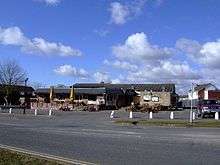
- Bullnose Morris, Cowley, Oxfordshire: Named after the motor cars once produced at the nearby factory.
- Coach and Horses: A simple and common name found from Clerkenwell to Kew, Soho to Portsmouth.
- Four In Hand Method of reining horses so four may be controlled by a single coach driver.
- I am the Only Running Footman, Mayfair, London W1; named after a servant employed by the wealthy to run ahead of their carriages and pay tolls.[56]
- Perseverance: Name of a stage coach. The Perseverance in Bedford probably alludes to John Bunyan's Pilgrim's Progress, Bedford being Mr Bunyan's home town.
- Scotchman and his Pack, Bristol. Nothing to do with Scotland. The pub is situated at the bottom of the very steep St Michael's Hill. Vehicles going up the hill were prevented from rolling downwards by means of wooden wedges, called scotches, placed behind the wheels by a scotchman who carried the scotches in a pack.
- Sedan Chair, Bristol, which like the Two Chairmen, London, is named after the carriers of sedan chairs.
- Steamer, Welwyn, Hertfordshire: It is found at the top of a steep hill where carriers required an extra horse (a cock-horse) to help get the wagon up the hill. After its exertion the cock-horse could be seen standing steaming on a cold day as its sweat evaporated.
- Terminus: Usually found where a tram route once terminated, sited near the tram terminus.
- Traveller's Rest, Northfield, Birmingham: a historic coaching inn on the main road to Bristol.
- Waggon and Horses: Another simple transport name (prior to American influence, the British English spelling of 'wagon' featured a double 'g',[57] retained on pub signs such as this one).
- Wait for the Waggon, Bedford and Wyboston, Bedfordshire: This is the name of the regimental march of The Royal Corps of Transport (now The Royal Logistic Corps), whose troops frequently use this route; the latter is sited on the Great North Road.
Water
- Navigation: Usually situated alongside a canal towpath. Many pubs take their names from the company which once owned a nearby railway line, canal or navigation. For example:
- Grand Junction, for the canal in Bulbourne, Hertfordshire; High Holborn and Harlesden, London.
- Grand Union, for the canal in Westbourne Park, Camden and Maida Vale
- Great Northern, for the Great Northern Railway, in Langley Mill and Thackley
- Great Western, for the Great Western Railway, in Paddington, Yeovil and Wolverhampton
- North Western: London and North Western Railway Company
- Shroppie Fly: Audlem, named after a type of canalboat called a 'Shropshire Fly'.[58]
- Trent Navigation: for the Trent Navigation Company
- Fellows, Morton and Clayton: for the Fellows Morton and Clayton Canal Company
- Tide End Cottages: in Teddington, at the end of the tidal reach of the River Thames
Other
- Air Balloon, Birdlip, Gloucestershire. Near a field where early ascents were made.[59]
- Goat and Tricycle, Bournemouth, Dorset, a humorous modern name.
- Rusty Bicycle, new name of the Eagle in Oxford. Oxford's students often cycle round the town.[60]
- Tram Depot, Cambridge: Occupies the building which once was the stables of Cambridge's tramway depot.
- Zeppelin Shelter, Aldgate, London, circa 1894, located opposite solid railway warehouses that were used in World War One (1914–1918) as East End civilian air raid shelters.
Most common
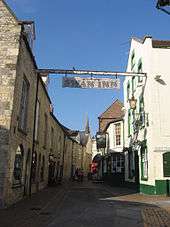
An authoritative list of the most common pub names in Great Britain is hard to establish, owing to ambiguity in what classifies as a pub as opposed to a licensed restaurant or nightclub, and so lists of this form tend to vary hugely. The two surveys most often cited, both taken in 2007, are by the British Beer and Pub Association (BBPA) and CAMRA.
According to BBPA, the most common names are:[61]
- Red Lion (759)
- Royal Oak (626)
- White Hart (427)
- Rose and Crown (326)
- King's Head (310)
- King's Arms (284)
- Queen's Head (278)
- The Crown (261)
and according to CAMRA they are:[62]
- Crown (704)
- Red Lion (668)
- Royal Oak (541)
- Swan (451)
- White Hart (431)
- Railway (420)
- Plough (413)
- White Horse (379)
- Bell (378)[63][64]
- New Inn (372)
A more current listing can be found on the Pubs Galore site, updated daily as pubs open/close and change names.[65] As of January 30, 2018, the top 10 were:
- Red Lion (567)
- Crown (530)
- Royal Oak (451)
- White Hart (324)
- Swan (309)
- Plough (301)
- Railway (299)
- White Horse (295)
- New (257)
- Ship (255)
The number of each is given in brackets.
Curiosities
The pubs with the shortest and longest names in Britain are both in Stalybridge: Q and The Old Thirteenth Cheshire Astley Volunteer Rifleman Corps Inn. The longest name of a London pub, I am the Only Running Footman, was used as the title of a mystery novel by Martha Grimes.
There is a "pub with no name" in Southover Street, Brighton.[66]
The Case is Altered, an early comedy by Ben Jonson, gives its name to several pubs.
The Salley Pussey's Inn at Royal Wootton Bassett is said to have been named after Sarah Purse, whose family owned The Wheatsheaf pub in the 19th century. In the 1970s the name was changed to the Salley Pussey's.[67]
See also
References
- ↑ "Ye". Merriam-Webster Online Dictionary. Retrieved 21 October 2016.
- 1 2 3 4 5 6 7 8 9 10 11 12 13 Saunders, Elain (2008). "A History of Britain in Its Pub Signs". TimeTravel-Britain. Retrieved 9 September 2016.
- 1 2 3 4 Simpson, Jacqueline (2011). Green Men & White Swans: The Folklore of British Pub Names. Random House. p. 249. ISBN 978-0-09-952017-7.
- ↑ Waterhouse, Keith "The Moon Under Water goes under" Daily Mail
- ↑ Johnson, Ben. "Pub Signs of Britain". Historic UK. Retrieved 9 September 2016.
- ↑ Dictionary of Pub Names. books.google.co.uk. Retrieved 26 July 2009.
- 1 2 The Wordsworth Dictionary of Phrase and Fable. Wordsworth Editions. 2001. p. 883.
- ↑ Dunkling L, Wright G (1994) [1987]. The Wordsworth Dictionary of Pub Names. Ware, Hertfordshire: Wordsworth Reference. ISBN 1-85326-334-6.
- ↑ see pub website, history page Archived 27 September 2007 at the Wayback Machine.
- ↑ "The Dolphin - Wellington, Somerset - Home". thedolphinwellington.co.uk.
- ↑ Rennison, Nick (2006). The Book of Lists, London. Canongate. p. 10. ISBN 978-1-84195-934-4.
- ↑ O'Brien, Harriet. "The Cat & Custard Pot Inn | Shipton Moyne, Gloucestershire, England". The Daily Telegraph. Retrieved 27 May 2018.
- ↑ Williams, Jennifer (19 November 2013). [Jabez Clegg "Manchester student nightspot Jabez Clegg closes after being sold to university"] Check
|url=value (help). Manchester Evening News. Retrieved 27 May 2018. - ↑ "Hobbit pub in Southampton threatened with legal action". BBC News. 13 March 2012.
- ↑ "Lass o'Gowrie".
- ↑ "The Moon and Sixpence". J. D. Wetherspoon. Retrieved 27 May 2018.
- ↑ Moody, Paul; Turner, Robin (8 December 2011). "What's your perfect pub?". The Guardian. Retrieved 9 September 2016.
- ↑ "Pevril of the Peak". Manchester History. Retrieved 27 May 2018.
- ↑ "Buildings with Sherlock Holmes connections". The Daily Telegraph. Retrieved 27 May 2018.
Not far from Charing Cross station is the Sherlock Holmes pub, which in the 1950s inherited the contents of an exhibition dedicated to Sherlock Holmes which had been created for the 1951 Festival of Britain. The owners installed a replica of Holmes’ and Watson’s sitting room and study in the pub which can still be seen today.
- ↑ "The Herbert Wells". J. D. Wetherspoon. Retrieved 27 May 2018.
- ↑ "The Edgar Wallace". The Edgar Wallace. Retrieved 27 May 2018.
- ↑ "The John Masefield | Our History". J. D. Wetherspoon. Archived from the original on 6 July 2017. Retrieved 27 May 2018.
- ↑ Rowan (1995). "The Temples of John Barleycorn". White Dragon. Retrieved 9 September 2016.
- ↑ "The Silent Woman Inn - Welcome to The Silent Woman". www.thesilentwoman.co.uk. Retrieved 15 October 2010.
- 1 2 Dictionary of Pub Names. Wordsworth Editions. 2006. p. 354. ISBN 1-84022-266-2. Retrieved 15 October 2010.
- ↑ Jacqueline Simpson (2010). Green Men and White Swans. Random House. ISBN 978-1-84794-515-0.
- ↑ Dictionary of Pub Names – Google Books. books.google.co.uk. Retrieved 26 July 2009.
- ↑ "Guy Earl Of Warwick". Pubs Galore.
- ↑ "London (South) 1896 Suburban Publicans directory listing - G". londonpublichouse.com.
- ↑ "Great Expectations". shu.ac.uk.
- ↑ "Real ale pubs and Inn's serving the finest pub food in Dartmoor, Devon". exclusivelydartmoor.co.uk.
- ↑ History of the Twelve Pins (brief). Retrieved on 2009-04-05.
- ↑ "The present sign is the innocuous replacement for one that became the centre of a storm a dozen or so years ago. As readers may remember, the original illustration was of a white couple trying to scrub the blackness off a black child in a tub. It was deemed by many to be in poor taste and potentially offensive, but there was an outcry when it was removed following a protest by two schoolgirls."
- ↑ "News: The latest North Wales news from the Daily Post". www.dailypost.co.uk.
- ↑ "What! Mr Scott was Black Bitch?".
- ↑ 'A place of this kind used as a cellar or storeroom for provisions or liquors.' Oxford English Dictionary, Second edition, 1989; online version June 2011. <http://www.oed.com/view/Entry/221743>; accessed 1 September 2011.
- ↑ Saunders, Elaine. "British Pub Signs - a short history". Britain Express. Retrieved 9 September 2016.
- ↑ "Britain's strangest pub names". Daily Telegraph. 15 Feb 2016.
- ↑ Brewer, E. Cobham (1898). "Dictionary of Phrase and Fable". Retrieved 17 October 2008.
- ↑ Dictionary of Pub Names – Google Books. books.google.co.uk. 2006. ISBN 978-1-84022-266-1. Retrieved 31 August 2009.
- 1 2 Wedgwood, Hensleigh (1855). "On False Etymologies". Transactions of the Philological Society (6): 64.
- ↑ Congleton history website
- ↑ "The Steveston - Buck & Ear - Hotel - Liquor Store - Cafe". stevestonhotel.ca.
- ↑ "Case is Altered". beerintheevening.com.
- ↑ "E. Cobham Brewer 1810–1897. Dictionary of Phrase and Fable. 1898". Retrieved 17 October 2008.
- ↑ Chaplin, Patrick (2009). "The Goat and Compasses". Pub History. Retrieved 9 September 2016.
- ↑ "Paraffin Oil Shop, Liverpool - another lost pub". www.closedpubs.co.uk.
- ↑ Lloyd, John (1972) The Township of Chorlton-cum-Hardy. Manchester: E. J. Morten; pp. 104–06
- ↑ Bruderer, Adam. "The not Oxford Road pub survey, October 2008" (PDF). Retrieved 13 July 2010.
- ↑ 1716, Dog and Duck sign from tavern on land belonging to the Bridge House Estates at St George's Fields: Image <http://hdl.handle.net/10427/15446> from the Bolles Collection (MS004) at the Digital Collections and Archives, Tufts University.
- ↑ The Manchester Courier And Lancashire General Advertiser July 8 1848
- ↑ Clitheroe's 1000 Years (A Langshaw)
- ↑ "The Chemic Tavern - Cosy, historic real ale pub in the heart of Woodhouse". The Chemic Tavern.
- ↑ "節税ノウハウ~交際費などわかりやすい". thejollynailor.com.
- ↑ "About – The Ship at Styal, Cheshire". www.theshipstyal.co.uk.
- ↑ Unusual names of pubs
- ↑ Bill Bryson, Mother Tongue, Penguin Books p169
- ↑ The Shroppie Fly website
- ↑ "Pubs in Birdlip - The Air Balloon - Old English Inns". airballoon-pub-gloucestershire.co.uk.
- ↑ "The Rusty Bicycle, Oxford - Cowley pub/food/functions - Arkell's Brewery Swindon". arkells.com.
- ↑ "British Beer and Pub Association Fact Sheet, 2007". BBPA.
- ↑ "Article at Solihull CAMRA site, 2007". CAMRA. Archived from the original on 1 March 2012.
- ↑ In 2008 it was claimed that the total number of names incorporating the word 'Bell' totalled 412.
- ↑ "Horfield Ringers - Bell Anthology". horfieldringers.org.
- ↑ "Common pub names on Pubs Galore". www.pubsgalore.co.uk.
- ↑ "The Southover". tripadvisor.com.au.
- ↑ Marshman, Mike (25 February 2014). "Sarah Purse becomes Sally Pussey". Wiltshire & Swindon History Centre. Retrieved 9 September 2016.
Sources
- Brewer, E. Cobham (1898) Dictionary of Phrase and Fable. London: Cassell and Co.
- Cox, Barrie (1994) English Inn and Tavern Names. Nottingham: Centre for English Name Studies, ISBN 978-0-9525343-0-3
- Dunkling, Leslie (1994) Pub Names of Britain, London: Orion (1994), ISBN 1-85797-342-9
- Dunkling, Leslie & Wright, Gordon (2006) The Dictionary of Pub Names. Ware: Wordsworth Editions ISBN 1-84022-266-2
- Myrddin ap Dafydd (1992) Welsh Pub Names. Llanrwst: Gwasg Carreg Gwalch ISBN 0-86381-185-X (Translation of: Enwau tafarnau Cymru)
- Wright, Gordon & Curtis, Brian J. (1995) Inns and Pubs of Nottinghamshire: the stories behind the names. Nottingham: Nottinghamshire County Council ISBN 0-900943-81-5
Further reading
- [Anonymous] (1969) Inn Signs: their history and meaning. London: the Brewers' Society
- Douch, H. L. (1966) Old Cornish Inns and their place in the social history of the County. Truro: D. Bradford Barton
- Richardson, A. E. (1934) The Old Inns of England. London: B. T. Batsford
External links
| Wikimedia Commons has media related to Pubs in the United Kingdom by name. |
- The Inn Sign Society
- Collection of images of Pub Signs
- Brewery Arts, a short history of studio inn signs